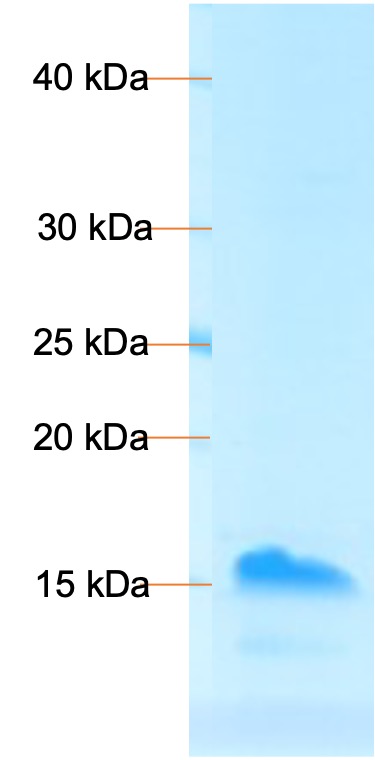Recombinant Human Interferon a/ beta Receptor 2/IFNAR2 (C-6His)
Shipping Info:
For estimated delivery dates, please contact us at [email protected]
| Amount : | 50 µg |
| Content : | Lyophilized from a 0.2 µm filtered solution of 20mM PB, 150mM NaCl, pH 7.2. |
| Storage condition : | Lyophilized protein should be stored at -20°C, though stable at room temperature for 3 weeks. Reconstituted protein solution can be stored at 4-7°C for 2-7 days. Aliquots of reconstituted samples are stable at -20°C for 3 months. |
| AA sequence : | ISYDSPDYTDESCTFKISLRNFRSILSWELKNHSIVPTHYTLLYTIMSKPEDLKVVKNCANTTRSFCDLTDEWRSTHEAYVTVLEGFSGNTTLFSCSHNFWLAIDMSFEPPEFEIVGFTNHINVMVKFPSIVEEELQFDLSLVIEEQSEGIVKKHKPEIKGNMSGNFTYIIDKLIPNTNYCVSVYLEHSDEQAVIKSPLKCTLLPPGQESESAESAKVDHHHHHH |
Source: Human Cells.
MW :25.79kD.
Recombinant Human Interferon alpha/beta Receptor 2 is produced by our Mammalian expression system and the target gene encoding Ile27-Lys243 is expressed with a 6His tag at the C-terminus. Interferon a/ beta Receptor 2 (IFN-a/ beta R2) is a single-pass type I membrane protein which belongs to the type II cytokine receptor family. It complexes with IFN-a/ beta R1 to form the signaling receptor complex for the family of a and beta IFN subtypes. By alternative splicing, IFN-a/ beta R2 can exist as a secreted soluble protein or as a type I membrane protein. IFN-a/ beta R2 is the principal ligand binding subunit of the receptor. Ligand binding is stabilized by the subsequent association with IFN-a/ beta R1, resulting in the formation of a signaling ternary receptor complex. IFNAR2 was detected in most lymphocytes, monocytes, and granulocytes, although IFNAR2 expression was higher in the monocytes and granulocytes than in the lymphocytes. Among the lymphocyte subsets, IFNAR2 showed high expression in natural killer (NK) cells and low expression in T lymphocytes. Isoform 1 and isoform 3 of IFNAR2 are directly involved in signal transduction due to their interaction with the TYR kinase, JAK1. Isoform 1 also interacts with the transcriptional factors, STAT1 and STAT2. Both forms are potent inhibitors of type I IFN activity.
MW :25.79kD.
Recombinant Human Interferon alpha/beta Receptor 2 is produced by our Mammalian expression system and the target gene encoding Ile27-Lys243 is expressed with a 6His tag at the C-terminus. Interferon a/ beta Receptor 2 (IFN-a/ beta R2) is a single-pass type I membrane protein which belongs to the type II cytokine receptor family. It complexes with IFN-a/ beta R1 to form the signaling receptor complex for the family of a and beta IFN subtypes. By alternative splicing, IFN-a/ beta R2 can exist as a secreted soluble protein or as a type I membrane protein. IFN-a/ beta R2 is the principal ligand binding subunit of the receptor. Ligand binding is stabilized by the subsequent association with IFN-a/ beta R1, resulting in the formation of a signaling ternary receptor complex. IFNAR2 was detected in most lymphocytes, monocytes, and granulocytes, although IFNAR2 expression was higher in the monocytes and granulocytes than in the lymphocytes. Among the lymphocyte subsets, IFNAR2 showed high expression in natural killer (NK) cells and low expression in T lymphocytes. Isoform 1 and isoform 3 of IFNAR2 are directly involved in signal transduction due to their interaction with the TYR kinase, JAK1. Isoform 1 also interacts with the transcriptional factors, STAT1 and STAT2. Both forms are potent inhibitors of type I IFN activity.
Always centrifuge tubes before opening. Do not mix by vortex or pipetting. It is not recommended to reconstitute to a concentration less than 100 µg/ml. Dissolve the lyophilized protein in ddH2O. Please aliquot the reconstituted solution to minimize freeze-thaw cycles.
Endotoxin : Less than 0.1 ng/µg (1 IEU/µg) as determined by LAL test.
For Research Use Only. Not for use in diagnostic/therapeutics procedures.
| Subcellular location: | Secreted |
| Post transnational modification: | Glycosylated. |
| Tissue Specificity: | Isoform 3 is detected in the urine (at protein level) (PubMed:8181059, PubMed:7759950). Expressed in blood cells. Expressed in lymphoblastoid and fibrosarcoma cell lines. |
| BioGrid: | 109677. 12 interactions. |
|
There are currently no product reviews
|
















.png)








